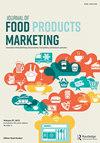贴着“自制”标签的食品是否含有更少的添加剂?一项巴西调查
IF 2.4
Q2 BUSINESS
引用次数: 7
摘要
摘要:本研究的目的是调查标签为“自制”的包装食品中食品添加剂的存在和类别。通过拍摄食品标签收集食品识别信息(n = 5,620);成分表随后被转录以供分析。成分表(标有“自制”和类似食品的食品)使用卡方检验比较了添加剂的存在和种类(功能),使用曼-惠特尼检验比较了添加剂的中位数。所有检验均以p < 0.05为显著性水平。我们评估了65种标有“自制”的产品和172种类似的传统产品。79% (n = 188)的产品(n = 237)含有添加剂。在是否含有添加剂方面,有“自制”声明的食品(81%)和没有的食品(78%)所占比例没有显著差异(p = .605)。在有和没有声明的食品中,添加剂的中位数(p = 0.61)和添加剂类别的数量(p = 0.79)没有观察到显著差异。它可以在全球范围内促进反思和制定公共政策,以制定使用或禁止使用标签上“自制”声明的标准。本文章由计算机程序翻译,如有差异,请以英文原文为准。
Do Foods Products Labeled “Home-made” Contain Fewer Additives? A Brazilian Survey
ABSTRACT The objective of this study was to investigate the presence and classes of food additives in packaged foods labeled ‘home-made’. Food identification information was collected by photographing food labels (n = 5,620); the ingredients lists were subsequently transcribed for analysis. The ingredients list (foods labeled ‘home-made’ and similar foods) were compared regarding the presence and classes of additives (function) using the chi-square test and regarding the median number of additives using the Mann–Whitney test. For all tests, p < .05 was used as the significance level. We evaluated 65 products labeled ‘home-made’ and 172 comparable conventional products. Seventy-nine percent (n = 188) of all products (n = 237) contained additives. There was no significant difference between the percentage of foods with the ‘home-made’ claim (81%) and those without (78%) regarding the presence of additives (p = .605). No significant difference was observed in the median number of additives (p = .61) and in the number of classes of additives (p = .79) between foods with and without the claim. It can contribute globally to the reflection and the creation of public policies for the elaboration of criteria for the use or prohibition of the use of “home-made” claims on labels.
求助全文
通过发布文献求助,成功后即可免费获取论文全文。
去求助
来源期刊

Journal of Food Products Marketing
BUSINESS-
CiteScore
5.70
自引率
6.90%
发文量
17
期刊介绍:
From food promotion and advertising through new food product development and consumer behavior research, the Journal of Food Products Marketing provides timely, practical articles that keep food marketers on the cutting edge of their profession. The journal includes refereed research studies as well as opinions, guidelines, and speeches by practitioners that contribute to the better practice and understanding of food marketing. The journal provides a single forum for both food marketing academicians and food marketing practitioners.
 求助内容:
求助内容: 应助结果提醒方式:
应助结果提醒方式:


